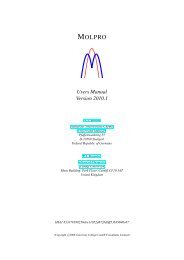CHAPTER II. POTENTIOMETRY AND REDOX TITRATIONS I ...
CHAPTER II. POTENTIOMETRY AND REDOX TITRATIONS I ...
CHAPTER II. POTENTIOMETRY AND REDOX TITRATIONS I ...
- No tags were found...
Create successful ePaper yourself
Turn your PDF publications into a flip-book with our unique Google optimized e-Paper software.
4I − + O 2 (g) + 4H + → 2I 2 + 2H 2 Owhich is promoted by acids, heat, and light.Preparation and Standardization:Standard solution of I − 3 can be prepared by adding iodate (IO − 3 ) to a small excess ofKI. Addition of excess strong acid (to give pH ≈ 1) produces I − 3 by quantitativereverse disproportionation.IO − 3 + I − + 6H + = 3I − 3 + 3H 2 OIodine solutions can be standardized by reaction with primary standard-gradeAs 4 O 6 .As 4 O 6 (s) + 6H 2 O = 4H 3 AsO 3(arsenious oxide) (arsenious acid)H 3 AsO 3 + I − 3 + H 2 O = H 3 AsO 4 + 3I − + 2H +Because the equilibrium constant is small, the concentration of H + must be kept low(e.g., by addition of sodium bicarbonate) to ensure complete reaction.v/. Application of Standard ReductantsStandard solutions of most reducing agents tend to react with atmospheric oxygenand are seldom used for direct titration of oxidizing analytes. Indirect methods areused instead.a) Reduction with Iron(<strong>II</strong>)Solutions of Fe(<strong>II</strong>) are readily prepared from iron(<strong>II</strong>) ammonium sulfate,Fe(NH 4 ) 2 (SO 4 ) 2 ⋅6H 2 O (Mohr’s salt) or form iron(<strong>II</strong>) ethylenediamine sulfate,FeC 2 H 4 (NH 3 ) 2 (SO 4 ) 2 ⋅4H 2 O (Oespar’s salt).Air-oxidation of Fe(<strong>II</strong>) takes place rapidly in neutral solutions but is inhibited in thepresence of acids.b) Reduction with ThiosulfateThiosulfate is a moderately strong reducing agent that is the almost universal titrant13











![Hetero [6+3] Cycloaddition of Fulvenes with N-Alkylidene Glycine ...](https://img.yumpu.com/35423358/1/190x245/hetero-6-3-cycloaddition-of-fulvenes-with-n-alkylidene-glycine-.jpg?quality=85)




